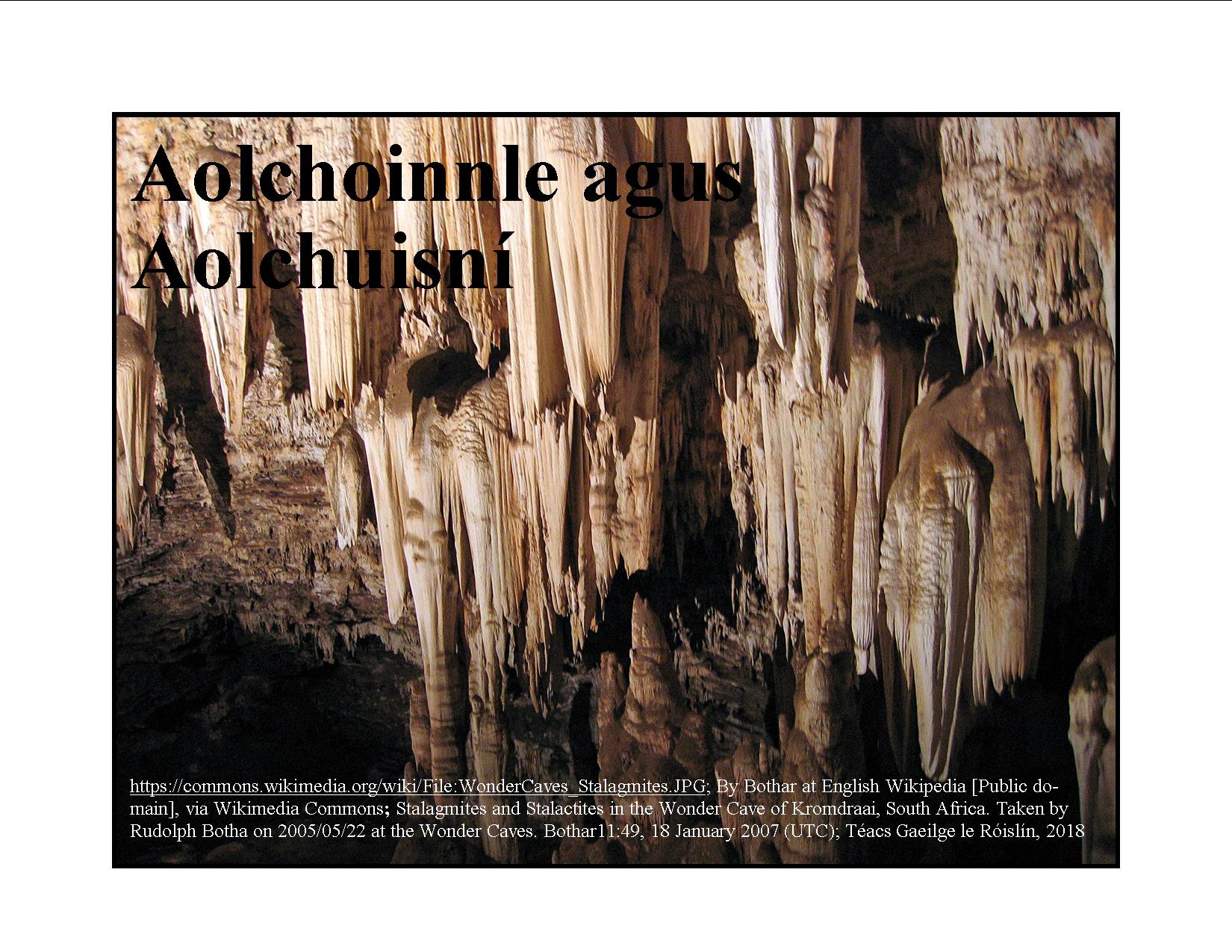Irish Words for Stalagmites and Stalactites Posted by róislín on Jul 18, 2018 in Irish Language
(le Róislín)
Since we recently looked at Irish words for caves (uaimheanna) and caving (uaimheadóireacht), in honor of the rescue of the Thai soccer team (nasc thíos), I thought this might be a good time to introduce the Irish words for “stalagmite” and “stalactite.”They’re really more straightforward and less technical-seeming than the English terms “stalagmite” and “stalactite,” since the Irish terms are based on relatively ordinary words (aol, coinneal, cuisne). Of those three, probably “cuisne” is somewhat less basic. We’ll see its core meaning below. But certainly the English words “stalagmite” and “stalactite” aren’t really connected to any everyday English words; the only related terms are the adjectives “stalagmitic” and “stalactitic.”
Let’s start with “stalagmite”:
Aolchoinneal, stalagmite, lit. “lime-candle,” referring to lime, the mineral substance, not “lime” (the fruit), which is “líoma.”
The plural is “aolchoinnle,” a logical extension of the plural of “coinneal” (candle), which is “coinnle.” It’s always good to learn plurals of nouns but in this case especially so, since I think stalagmites always come in groups. Anyone ever see a cave with just one stalagmite?
And the idea of the candle makes it so much easier to remember which formation rises from the floor of the cave (stalagmite) and which one hangs from the roof (stalactite). The English words give one no clue. The only way I finally memorized which was which as a child was from the “mites go up” mnemonic. Anyone else finally learn the difference that way?
Actually I just checked online and there’s another mnemonic as well: stalagmites push up with all their might and stalactites hang on tight to the roof.
But the Irish words don’t really need a mnemonic since candles usually stand upright on a surface.
The Irish for “stalactite” is “aolchuisne,” which is, admittedly a little more bizarre in translation. The first element (aol) is the same as in “aolchoinneal.” “Cuisne” has several meanings, none of which really remind me of stalactites. It can mean “hoar-frost,” “frosty vapor,” “rime,” or a “cold haze.” OK, whatever. The more basic word for “frost” is “sioc” (ag cur seaca, etc.), which is probably a lot more familiar. Of course, even in English, I don’t think I’ve had much reason to use the word “hoar-frost,” since perhaps reading “The Rime of the Ancient Mariner” or maybe it was Jules Verne’s An Antarctic Mystery, set on the remote Kerguelen Islands. Note the Breton name there, you Pan-Celticists out there.
The plural of “aolchuisne” is straightforward enough: aolchuisní (stalactites). But it’s interesting that “cuisne” itself is what we’d call an “uncountable” noun in English. It doesn’t have a plural and you can’t count individual “cuisne.” But once we apply the word to a tangible physical object, this aspect changes, and we can simply use a typical Irish plural ending, “-í”.
What happens when we add the word “the” (“an” in Irish) in front of the noun? Well, “aolchoinneal” is grammatically feminine, so we say “an aolchoinneal.” No changes. But “aolchuisne” is masculine, so, do you remember the rule for masculine singular nouns after “an” (the)? We add the “t-“ as in “an t-úll” or “an t-uisce.” So we have “an t-aolchuisne.” In the plural, grammatical gender doesn’t matter, but we do have the “h-“ prefixing: na haolchoinnle and na haolchuisní.
I don’t know if aolchoinnle and aolchuisní were part of the attraction that drew the Thai boys to the cave they explored, but at any rate, they are a constantly fascinating feature of many caves and caverns, often imaginatively named. An raibh tusa riamh in uaimh a raibh aolchoinnle agus aolchuisní ann? If so, it would be great if you could write in and tell us about it. SGF — Róislín
Nasc: Uaimheanna agus Uaimheadóireacht: Words for Caves and Caving in IrishPosted by róislín on Jul 15, 2018 in Irish Language

Build vocabulary, practice pronunciation, and more with Transparent Language Online. Available anytime, anywhere, on any device.





Leave a comment: